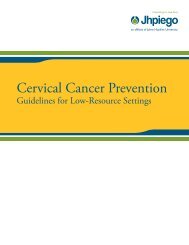Manual for Male Circumcision under Local Anaesthesia
Manual for Male Circumcision under Local Anaesthesia
Manual for Male Circumcision under Local Anaesthesia
Create successful ePaper yourself
Turn your PDF publications into a flip-book with our unique Google optimized e-Paper software.
<strong>Male</strong> circumcision <strong>under</strong> local anaesthesia<br />
Version 3.1 (Dec09)<br />
widely per<strong>for</strong>med <strong>for</strong> religious or cultural reasons, while in others it is<br />
per<strong>for</strong>med principally on medical grounds. In order to make an<br />
in<strong>for</strong>med decision, every potential client or parent is entitled to full<br />
in<strong>for</strong>mation about the benefits and risks of the procedure.<br />
The decision of an adult or young man to be circumcised, and<br />
the decision of a parent to have his or her son circumcised,<br />
should be based on culture, religion, personal preference, and<br />
evidence-based in<strong>for</strong>mation provided by a health care worker.<br />
Benefits<br />
If circumcision is being done <strong>for</strong> reasons other than the treatment of a<br />
specific medical problem, the health benefits are primarily preventive,<br />
and may only be realized long after the procedure. <strong>Circumcision</strong> may<br />
reduce the risk of acquiring some infections and related complications,<br />
but does not guarantee complete protection. Some of these conditions<br />
are common, while others are less so, and the degree of risk of the<br />
individual is likely to depend on his behaviour and where he lives.<br />
Although the strength of the evidence varies by disease, the benefits<br />
of circumcision include the following:<br />
• It is easier to keep the penis clean.<br />
• There is a reduced risk of urinary tract infections in childhood. 1<br />
• <strong>Circumcision</strong> prevents inflammation of the glans (balanitis) and the<br />
<strong>for</strong>eskin (posthitis).<br />
• <strong>Circumcision</strong> prevents the potential development of scar tissue on<br />
the <strong>for</strong>eskin, which may lead to phimosis (inability to retract the<br />
<strong>for</strong>eskin) and paraphimosis (swelling of the retracted <strong>for</strong>eskin<br />
resulting in inability to return the <strong>for</strong>eskin to its normal position).<br />
• There is a reduced risk of some sexually transmitted infections<br />
(STIs), especially ulcerative diseases, such as chancroid and<br />
syphilis. 2, 3<br />
• There is a reduced risk of becoming infected with human<br />
4, 5, 6, 7, 8<br />
immunodeficiency virus (HIV).<br />
9, 10<br />
• There is a reduced risk of penile cancer.<br />
• There is a reduced risk of cancer of the cervix in female sex<br />
partners. 11<br />
Risks<br />
As <strong>for</strong> any surgical procedure, there are risks associated with<br />
circumcision. While the benefits of circumcision may be wide-ranging<br />
and long-term, any problems generally occur during or soon after the<br />
procedure. They include:<br />
• pain;<br />
• bleeding;<br />
• haematoma (<strong>for</strong>mation of a blood clot <strong>under</strong> the skin);<br />
• infection at the site of the circumcision;<br />
• increased sensitivity of the glans penis <strong>for</strong> the first few months<br />
after the procedure;<br />
• irritation of the glans;<br />
• meatitis (inflammation of the opening of the urethra);<br />
• injury to the penis;<br />
<strong>Male</strong> circumcision and HIV infection Chapter 1-2
















